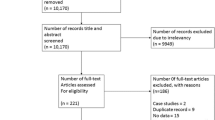Abstract
We sought to describe: (1) the prevalence of internet, cellular phone, and text message use among women attending an urban sexually transmitted infections (STI) clinic, (2) the acceptability of health advice by each mode of information and communication technology (ICT), and (3) demographic characteristics associated with ICT use. This study is a cross-sectional survey of 200 English-speaking women presenting to a Baltimore City STI clinic with STI complaints. Participants completed a self-administered survey querying ICT use and demographic characteristics. Three separate questions asked about interest in receiving health advice delivered by the three modalities: internet, cellular phone, and text message. We performed logistic regression to examine how demographic factors (age, race, and education) are associated with likelihood of using each modality. The median age of respondents was 27 years; 87% were African American, and 71% had a high school diploma. The rate of any internet use was 80%; 31% reported daily use; 16% reported weekly use; and 32% reported less frequent use. Almost all respondents (93%) reported cellular phone use, and 79% used text messaging. Acceptability of health advice by each of the three modalities was about 60%. In multivariate analysis, higher education and younger age were associated with internet use, text messaging, and cellular phone use. Overall rate of internet use was high, but there was an educational disparity in internet use. Cellular phone use was almost universal in this sample. All three modalities were equally acceptable forms of health communication. Describing baseline ICT access and the acceptability of health advice via ICT, as we have done, is one step toward determining the feasibility of ICT-delivered health interventions in urban populations.
Similar content being viewed by others
References
Hutton HE, McCaul ME, Santora PB, Erbelding EJ. The relationship between recent alcohol use and sexual behaviors: gender differences among sexually transmitted disease clinic patients. Alcohol Clin Exp Res. 2008; 32(11): 2008-2015. Epub 6 Sep 2008.
Linke S, Murray E, Butler C, Wallace P. Internet-based interactive health intervention for the promotion of sensible drinking: patterns of use and potential impact on members of the general public. J Med Internet Res. 2007; 9(2): e10.
Riper H, Kramer J, Smit F, Conijn B, Schippers G, Cuijpers P. Web-based self-help for problem drinkers: a pragmatic randomized trial. Addiction. 2008; 103(2): 218-227.
Vidrine DJ, Arduino RC, Lazev AB, Gritz ER. A randomized trial of a proactive cellular telephone intervention for smokers living with HIV/AIDS. AIDS. 2006; 20(2): 253-260.
Rodgers A, Corbett T, Bramley D, Riddell T, Wills M, Lin RB. Do u smoke after txt? Results of a randomised trial of smoking cessation using mobile phone text messaging. Tob Control. 2005; 14(4): 255-261.
Levine D, McCright J, Dobkin L, Woodruff AJ, Klausner JD. SEXINFO: a sexual health text messaging service for San Francisco youth. Am J Public Health. 2008; 98(3): 393-395.
Rietmeijer CA, Bull SS, McFarlane M, Patnaik JL, Douglas JM Jr. Risks and benefits of the internet for populations at risk for sexually transmitted infections (STIs): results of an STI clinic survey. Sex Transm Dis. 2003; 30(1): 15-19.
Kalichman SC, Weinhardt L, Benotsch E, DiFonzo K, Luke W, Austin J. Internet access and internet use for health information among people living with HIV–AIDS. Patient Educ Couns. 2002; 46(2): 109-116.
Mayben JK, Giordano TP. Internet use among low-income persons recently diagnosed with HIV infection. AIDS Care. 2007; 19(9): 1182-1187.
U.S. Census Bureau, Statistical Abstract of the United States: 2009 (128th Edition) Washington, DC, 2008. Available at: http://www.census.gov/compendia/statab/cats/information_communications/internet_publishing_and_broadcasting_and_internet_usage.html. Accessed on: August 20, 2009.
Peterson NB, Dwyer KA, Mulvaney SA. Computer and internet use in a community health clinic population. Med Decis Making. 2009; 29(2): 202-206.
Harris Interactive. The Harris Poll #36, April 4, 2008. Available at: http://www.harrisinteractive.com/harris_poll/index.asp?PID=890. Accessed on: February 22, 2009.
Pew Internet & American Life Project. Pew Internet Project Data Memo. Available at: http://www.pewinternet.org/∼/media//Files/Reports/2006/PIP_Cell_phone_study.pdf. Accessed on: July 29, 2009.
Blumberg SJ, Luke JV. Reevaluating the need for concern regarding noncoverage bias in landline surveys. Am J Public Health. 2009; 99(10): 1806-1810.
Cunningham JA, Humphreys K, Koski-Jannes A, Cordingley J. Internet and paper self-help materials for problem drinking: is there an additive effect? Addict Behav. 2005; 30(8): 1517-1523.
Hester RK, Squires DD, Delaney HD. The Drinker’s Check-Up: 12-month outcomes of a controlled clinical trial of a stand-alone software program for problem drinkers. J Subst Abuse Treat. 2005; 28(2): 159-169.
Kypri K, Saunders JB, Williams SM, et al. Web-based screening and brief intervention for hazardous drinking: a double-blind randomized controlled trial. Addiction. 2004; 99(11): 1410-1417.
Neighbors C, Larimer ME, Lewis MA. Targeting misperceptions of descriptive drinking norms: efficacy of a computer-delivered personalized normative feedback intervention. J Consult Clin Psychol. 2004; 72(3): 434-447.
Weitzel JA, Bernhardt JM, Usdan S, Mays D, Glanz K. Using wireless handheld computers and tailored text messaging to reduce negative consequences of drinking alcohol. J Stud Alcohol Drugs. 2007; 68(4): 534-537.
Joo NS, Kim BT. Mobile phone short message service messaging for behaviour modification in a community-based weight control programme in Korea. J Telemed Telecare. 2007; 13(8): 416-420.
Acknowledgements
We would like to acknowledge the assistance of clinical informationist Blair Anton, MLIS, MS, at the Welch Medical Library of Johns Hopkins University School of Medicine.
A poster based on this study was presented at the 32nd Annual Meeting of the Society of General Internal Medicine, May 13–16, 2009, Miami Beach, FL.
Author information
Authors and Affiliations
Corresponding author
Rights and permissions
About this article
Cite this article
Samal, L., Hutton, H.E., Erbelding, E.J. et al. Digital Divide: Variation in Internet and Cellular Phone Use among Women Attending an Urban Sexually Transmitted Infections Clinic. J Urban Health 87, 122–128 (2010). https://doi.org/10.1007/s11524-009-9415-y
Published:
Issue Date:
DOI: https://doi.org/10.1007/s11524-009-9415-y




